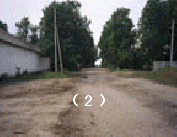|
The
three travelers decided to pay a visit at the grocery store they
found near by to replenish their stock of lunchmeats, bread,
cheeses and bottles of yogurt drinks and juices. They continued
on their journey by cruising westward on the main road.
The road was quiet even though it was early afternoon.
A few pedestrians, mostly middle-aged women, passed the
conspicuous Honda; they gave no notice to the strangers inside.
After
driving for about five minutes or so, they arrived at the
western exit of the village where a wooden bridge crossed over a
narrow river. There was, however, another village on the other
side of the bridge – a perfect place for a U-turn. Vlad
found the office of the state administration on the way back to
the three-ways intersection; it is located in the center of the
village. Most of
the pedestrians seen passing earlier re-appeared at this the
office. They are
most likely picking up their monthly stipend or pensions.
Vlad
went inside facilities to secure interviews with the officials
while Heidi and Norimi waited in the car and watched the
passers-by. Vlad told the two to come inside to visit with one of the
officials. Unfortunately,
the state official could offer only limited information
about the village. He
introduced himself as a director for the village and yet
appeared to be a reluctant informant for the strange tourists.
Norimi was told of the two thousand people who currently
inhabited the village. The official was unable to tell the group
anything about the village’s ethnic composite or the ages,
occupations or gender of the residents. There was, however, a
wall-size detailed map of the village.
The three visitors were allowed to take some photographs
of the map. Among
the facilities within the state office were the registrar,
pension office and the sheriffs’ department.
Heidi,
Norimi and Vlad continued their tour heading northward.
Driving the car as slowly as possible, Norimi took many
photographs and video shots.
His subjects included a horse-drawn wagon filled with hay
with a little boy at the reins; military trucks and construction
vehicles, which passed through the village.
It was apparent that the village stood between roads that
led to major towns and cities.
Bagrinovtsy
is an oasis, a little quiet village in the vast Podolia plain.
It took only ten minutes for the three visitors from the
Pervin tree to arrive at the north exit of the village.
There they saw a never-ending view of meadows spread to
the horizon. The road lined with tall birch trees continued
ahead to Litinka, the next village via the state highway M12.
The three enjoyed a picnic lunch, as they over looked the
vast rich land, attractive to so many foreign invaders. Heidi
and Norimi agreed with the invaders’ obsessions and cravings
for its possession. The
breeze carried a fragrance of honey, the sweet breath of the
meadow. They felt
that in that moment they had touched a small fragment of heaven.
The wooden fences bordering the sugar beets field were
made of natural tree branches woven uniquely.
Norimi
could not help sensing a mysterious veil shielding the village
from its past. The
villagers smiled and greeted the strangers in the car.
And yet they kept their distance from any unnecessary
acquaintance with the outsiders.
One farmer came by to offer posing for a photograph with
his wife. Norimi
agreed. But his
wife who shied away from the strangers rejected the farmer’s
offer. Other than a few old buildings, most of the houses appeared
relatively new according to Vlad, possibly built after the
revolution. The few
ancient mud houses stood devastated behind brushes and old big
oak trees. Norimi regretted only that he could not talk to the
old oak trees. He
did enjoy the deep blue clematis vines blossoming in the
farmers’ gardens.
Heidi
and Vlad enjoyed spending some time at a public well for an
ice-cold drink of water. The
wells were well kept in the village.
Each well was decorated uniquely.
There
were 3 visits to Bagrinovtsy. And each time they encountered a
large herd of cows cruising through the village.
On the last of the 3 visits, the travelers gave a sheriff
a ride to Litin who usually commuted, daily, to Bagrinovtsy from
Litin by foot. |

